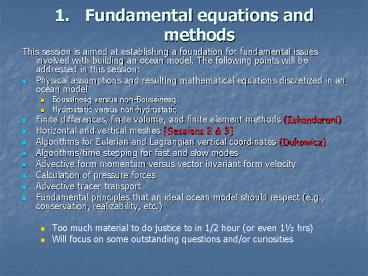Fundamental equations and methods PowerPoint PPT Presentation
1 / 15
Title: Fundamental equations and methods
1
Fundamental equations and methods
- This session is aimed at establishing a
foundation for fundamental issues involved with
building an ocean model. The following points
will be addressed in this session - Physical assumptions and resulting mathematical
equations discretized in an ocean model - Boussinesq versus non-Boussinesq
- Hydrostatic versus non-hydrostatic
- Finite differences, finite volume, and finite
element methods (Iskandarani) - Horizontal and vertical meshes Sessions 2 3
- Algorithms for Eulerian and Lagrangian vertical
coordinates (Dukowicz) - Algorithms/time stepping for fast and slow modes
- Advective form momentum versus vector invariant
form velocity - Calculation of pressure forces
- Advective tracer transport
- Fundamental principles that an ideal ocean model
should respect (e.g., conservation,
realizability, etc.) - Too much material to do justice to in 1/2 hour
(or even 1½ hrs) - Will focus on some outstanding questions and/or
curiosities
2
The equations we cant afford to solve
- Navier-Stokes equations
- Cant solve for climate for two reasons
- Scales at which molecular processes act are tiny
(Kolmogorov ) - Permits sounds waves
Usually replace T with ?
3
1. Reynolds averaging
- Define some average/filter/ensemble s.t.
- Minefield for the non-theoretical!
- Note absence of Reynolds fluxes in continuity
- Due to definition of flow as rate of mass
transport? - Molecular terms ltlt eddy terms
- Can we drop molecular terms?
- Curiosity - B.C.s for eddy fluxes?
4
2. Muting the ocean (filtering sound)
- Sound waves essentially linear
- Very fast
- Filter with either
- An-elastic approximation
- Hydrostatic balance (vertical momentum)
- Lamb mode (where is it?)
- (often use both) (or modifying E.O.S.) (or
)
5
Scaling continuity
- Partition the full flow into
- horizontally non-divergence component
- horizontally divergent/3D non-divergent
- 3D divergent component
6
Oceanic Boussinesq approximation
- Boussinesq approximation is most associated with
z-coordinates for historical reasons - rigid-lid -gt z-coordinates -gt Boussinesq
- Would not consider it now if we hadnt already
used it! - Justification
- Misunderstandings
- because
7
Isomorphisms
- Boussinesq (z)
- Free boundary
- Rigid boundary
- Non-Boussinesq (p)
- Free boundary
- Rigid boundary
Identical dynamics described by
Boussinesq/non-Boussinesq equations
8
Energy (currency of physics)
- Navier-Stokes energetics
- Conversion between K?F and K?I
- Boussinesq energetics
- This is what the real fluid would be doing with
the Boussinesq solution! - Do models need to conserve K, ? and I?
- and has any model ever done so?
- Conserve versus diminish?
9
Non-hydrostatic modeling
- Scaling the vertical momentum equation
- Non-dimensional
- Ratios
- Note that Marshall et al., 95 obtained from the
buoyancy equation - For large scale flows, makes
smaller - NH modeling is more expensive
- NH modeling is easiest with Boussinesq
10
Assumptions unworthy of mention
- Thin atmosphere (ocean) approximation
- Trivial to relax by modifying geometry of grid
- Spherical earth
- Easy to include, again through geometric terms
- Constant gravitational acceleration
- Only if you use g!
- Neglect of self-attraction and loading
- Tough one but needed for tides. Not climate?
- Circulation alteration by ocean fauna
- Surface tension
- Some rocks are more solid than others
- Two component fluid (solution energy of CFCs!)
- Non-continuum nature of a fluid (Brownian motion)
- Relativistic corrections
11
Properties of the continuum to guide numerics
- Tracer equations exhibit various symmetries
- Higher moments (used by Bryan, 1969)
- Led to particular spatial discretizations
(ignoring time) - e.g. globally conserve ?2
- Higher accuracy regains some credibility
- Observing monotonicity/extrema
- Has led to flux correctors/limiters
- Space-time treatment
Unlimited schemes of various orders
As above with various limiters
Which is better physically more realizable
solution or formally more accurate?
12
Vector invariant form
- Traditionally z-coordinate models used
conservative form of momentum equations - Requires metric terms specific to horizontal
coordinate system - Layered models more often than not use the vector
invariant form - Invariant for orthogonal coordinate systems
- Very similar form for non-orthogonal coordinates
- Very convenient to access PV Q(f?)/h
- and PV related quantities (hQ, Q2, etc)
- And KE
13
Similar approaches for momentum?
- PV is a scalar (PV eqn is a tracer equation)
- In layered framework, Coriolis terms are just
the advective transport of PV - Applying tracer technology to q avoids
oscillations in q - If we can do same for K, then can drop explicit
viscosity needed for numerical stability - By advecting PV, flow may change
- Q Do passive tracer principles apply to PV?
14
Burgers equation
- Inviscid self-advection of momentum
- Centered F.D. can be very unstable
- Non-linear methods (e.g. upwinding) produces
physically more realizable solutions - Enquist-Oscilles scheme
- Gudonov scheme
- Numerical viscosity versus explicit dissipation?
- Which is better physically more realizable
solution or formally more accurate?
15
Solvers!
- Traditionally, ocean models solve each equation
independently - CFD solvers often solve system as a whole
- With all the limiters etc
- Any advantage of one approach over the other?

